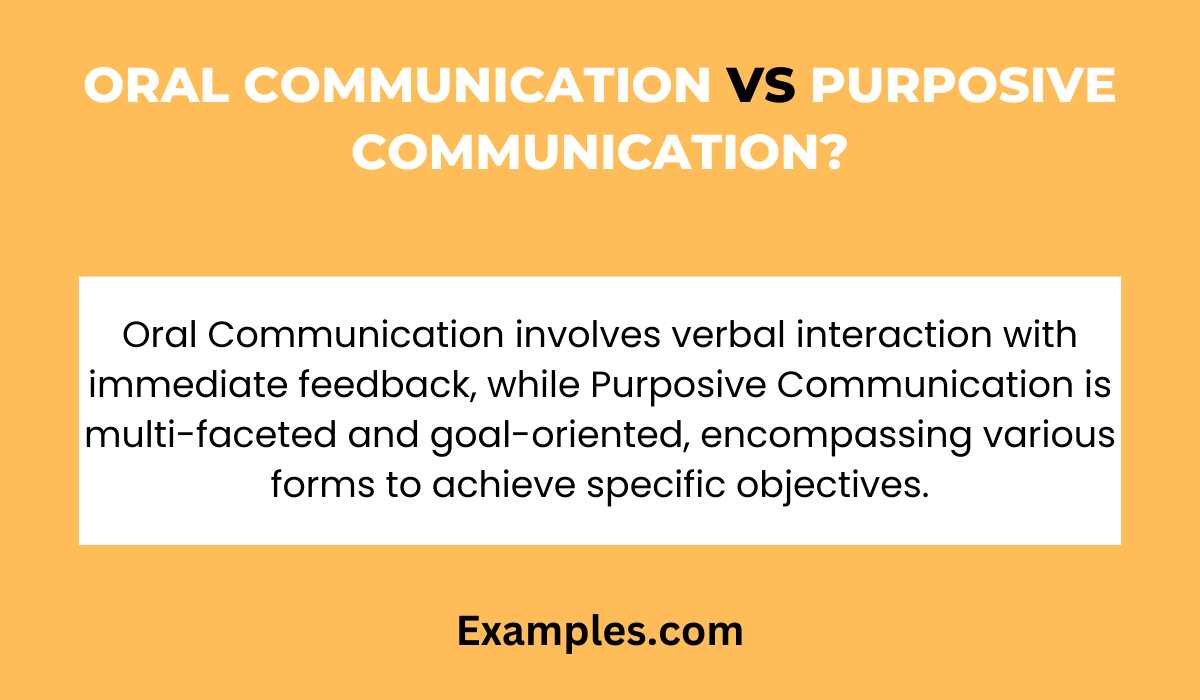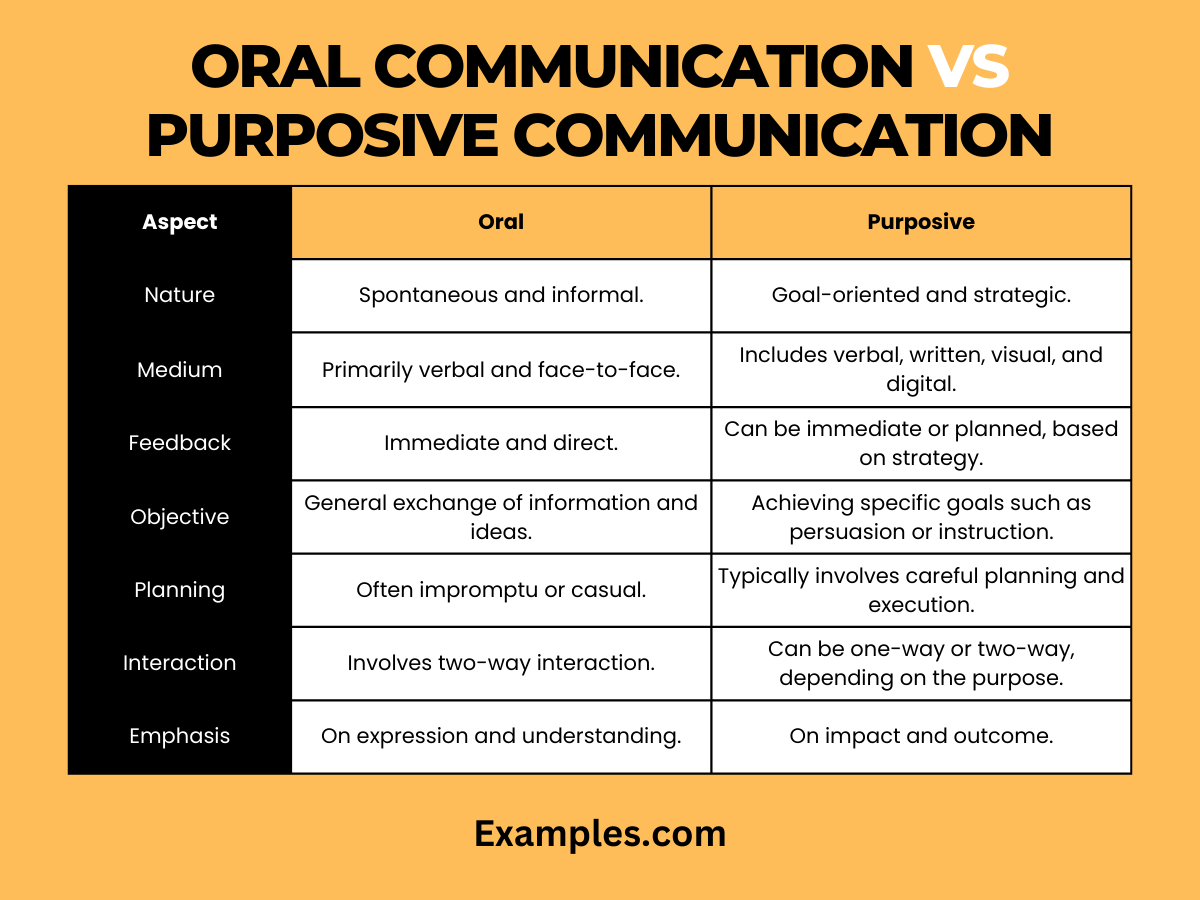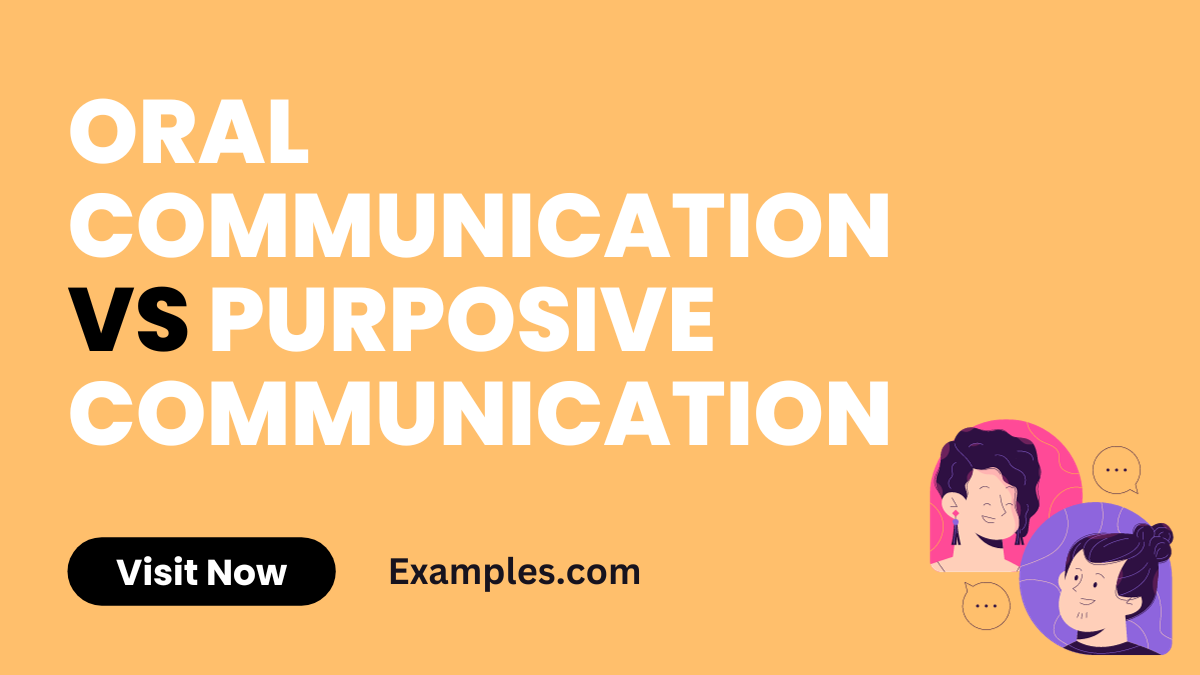Oral Communication vs Purposive Communication
Exploring the realms of Oral Communication and Purposive Communication unveils distinct approaches to conveying messages. This guide offers a deep dive into both, enriched with communication examples and practical applications. While oral communication covers a broad spectrum of interpersonal interactions, purposive communication is more goal-oriented, focusing on achieving specific objectives. Understanding these nuances is essential for anyone looking to refine their communication skills in various contexts, from casual dialogues to strategic discussions.
Oral Communication vs Purposive Communication? – Definition

Oral Communication is the process of expressing ideas and information verbally in various interactions, characterized by immediacy and direct feedback. It includes elements like tone, volume, and body language. Purposive Communication, in contrast, is goal-oriented, encompassing not only oral but also written, visual, and digital forms. It’s strategically designed to achieve specific objectives, such as persuading or informing an audience. Understanding these differences is key to selecting the appropriate communication style for different contexts and goals.
Differences between Oral Communication vs Purposive Communication

| Aspect | Oral Communication | Purposive Communication |
|---|---|---|
| Nature | Spontaneous and informal. | Goal-oriented and strategic. |
| Medium | Primarily verbal and face-to-face. | Includes verbal, written, visual, and digital. |
| Feedback | Immediate and direct. | Can be immediate or planned, based on strategy. |
| Objective | General exchange of information and ideas. | Achieving specific goals such as persuasion or instruction. |
| Planning | Often impromptu or casual. | Typically involves careful planning and execution. |
| Interaction | Involves two-way interaction. | Can be one-way or two-way, depending on the purpose. |
| Emphasis | On expression and understanding. | On impact and outcome. |
| Flexibility | Adaptable to the audience’s immediate response. | Structured to meet pre-defined objectives. |
| Scope | Personal, social, or professional communication. | Often used in marketing, public relations, and brand communication. |
| Tools | Tone, body language, facial expressions. | All forms of communication tools, including media and technology. |
10 Oral Communication Examples
Oral communication is vital in everyday interactions, involving skills that enhance clarity, engagement, and understanding in face-to-face conversations. Below are 10 key oral communication skills, each accompanied by a unique example showcasing its practical application.
- Active Listening: Paying full attention to the speaker.
Example: “I understand your concern; let’s explore solutions together.” - Clarity: Conveying messages in a clear, understandable manner.
Example: “Our goal is to increase productivity by 20% this quarter.” - Confidence: Speaking assertively to convey conviction.
Example: “I am confident this plan will lead us to success.” - Empathy: Showing understanding and concern in communication.
Example: “I can see why this situation is difficult for you.” - Adaptability: Tailoring your communication style to the audience.
Example: Adjusting your tone when speaking to different groups. - Feedback: Providing and receiving constructive responses.
Example: “Your feedback on this project would be invaluable.” - Non-Verbal Cues: Using body language to reinforce your message.
Example: Nodding and maintaining eye contact while listening. - Persuasion: Convincing others of your viewpoint.
Example: “Investing in this will yield significant long-term benefits.” - Articulation: Speaking clearly and distinctly.
Example: “Let me outline the steps involved in this process.” - Storytelling: Using narratives to engage and illustrate points.
Example: “Let me share a success story that relates to this strategy.”

10 Purposive Communication Examples
Purposive communication is strategic and goal-oriented, designed to achieve specific objectives. Here are 10 essential purposive communication skills, each with an illustrative example.
- Clear Goal Setting: Defining specific communication objectives.
Example: “Our aim is to increase brand awareness among millennials.” - Audience Analysis: Understanding the audience’s needs and preferences.
Example: “This campaign targets tech-savvy young adults.” - Message Structuring: Organizing content to achieve goals.
Example: “The presentation starts with problems faced, followed by our solutions.” - Channel Selection: Choosing the most effective medium for your message.
Example: Opting for social media campaigns for younger demographics. - Call to Action: Encouraging the audience to take a specific action.
Example: “Visit our website to learn more about this exciting offer.” - Feedback Mechanism: Incorporating ways to gather audience responses.
Example: “Please fill out this survey to let us know your thoughts.” - Consistency: Maintaining a consistent message across platforms.
Example: Aligning messages in advertisements, social media, and press releases. - Visual Aids: Using visuals to enhance understanding and retention.
Example: Incorporating infographics in presentations for clarity. - Strategic Planning: Developing a plan to convey the message effectively.
Example: Outlining a year-long marketing strategy with specific milestones.

- Analytical Skills: Evaluating the effectiveness of communication.
Example: Analyzing campaign data to assess its impact on sales.
Each of these skills plays a pivotal role in ensuring that oral and purposive communication is effective, engaging, and aligns with the intended goals and objectives.
Importance of Oral Communication vs Purposive Communication
Both Oral and Purposive Communication play vital roles in different contexts, especially in the realm of brand communication. Here are ten points that underscore their significance:
- Versatility: Oral communication is versatile and can adapt to various situations, while purposive communication is essential for targeted messaging.
- Immediate Rapport: Oral communication helps in building immediate rapport with the audience, crucial in customer interactions and negotiations.
- Brand Messaging: Purposive communication is key in delivering consistent brand messaging across various platforms.
- Feedback Mechanism: Oral communication provides a quick feedback mechanism, essential for real-time adjustments.
- Strategic Planning: Purposive communication involves strategic planning, aligning with the brand’s long-term goals.
- Personalization: Oral communication allows for personalization, an important aspect in customer service and relationship building.
- Wide Reach: Purposive communication can reach a wider audience through multiple channels.
- Crisis Management: Oral communication is effective in crisis situations, offering clarity and immediacy.
- Campaign Effectiveness: Purposive communication enhances the effectiveness of marketing campaigns through focused messaging.
- Adaptability: Oral communication is adaptable to immediate audience reactions, beneficial in presentations and public speaking.
What is the Relationship Between Oral Communication vs Purposive Communication
Here’s a table summarizing the relationship between Oral Communication and purposive communication:
| Aspect | Relationship |
|---|---|
| Definition | Oral Communication is spoken interaction; purposive communication is goal-directed in any form. |
| Objective | Oral focuses on verbal exchange; purposive aims at achieving specific goals. |
| Medium | Oral uses speech; purposive can be oral, written, or non-verbal. |
| Feedback | Oral allows immediate feedback; purposive feedback varies by medium and goal. |
| Adaptability | Oral is flexible and spontaneous; purposive is often more structured. |
| Audience Engagement | Oral involves direct interaction; purposive targets specific audience needs. |
| Context | Oral can be informal/formal; purposive is contextually tailored to objectives. |
This table shows how Oral Communication and purposive communication are related yet distinct, each serving unique functions in the domain of effective communication.
Understanding the nuances between Oral and Purposive Communication is vital for effective expression and strategic interaction. While oral communication excels in personal immediacy and adaptability, purposive communication is key for achieving specific objectives with a targeted approach. Mastering both forms equips individuals and organizations with the versatility to navigate diverse communicative scenarios, enhancing overall engagement and impact.
The exploration of Oral Communication vs Purposive Communication reveals distinct yet complementary communication strategies. Oral communication excels in spontaneous, personal interactions, while purposive communication is goal-oriented, encompassing a broader array of communication forms including digital and visual. For further insights into these communication styles, the Toastmasters International website offers valuable resources on effective oral communication skills. Additionally, the American Management Association provides comprehensive guidance on purposive communication strategies in business contexts. These authoritative sources deepen the understanding of both communication styles, emphasizing their unique roles and synergies in various professional and personal scenarios.



